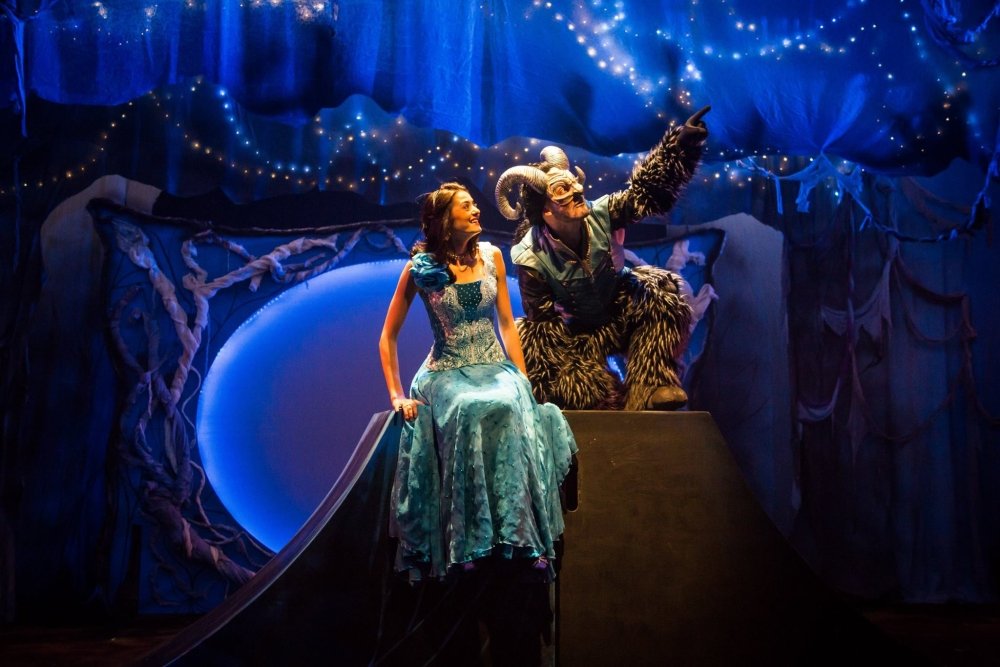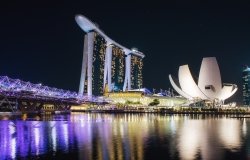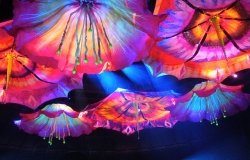“Beauty and the Beast:” A Tale of Entrepreneurship and Community
Now over a decade old, Synetic [Theater] – which is based in Arlington’s Crystal City – has joined the upper ranks of the Washington theater scene with hauntingly scored, visually striking , and physically demanding performances that have made the company among the most widely praised practitioners of physical theater anywhere.

Synetic Theater has another hit on its hands with its new production of Beauty and the Beast. “It gives you goosebumps,” writes the website Broadway World; “A lush, almost feverish theatrical experience, impressive to see and satisfying,” gushes Talkin’ Broadway blog; “fresh and frightening,” declares the Washington City Paper; and “graphically clever” as well as “bewitchingly ideal conveyance,” notes the doyen of Washington critics Peter Marks in the Washington Post.
Now over a decade old, Synetic – which is based in Arlington’s Crystal City – has joined the upper ranks of the Washington theater scene with hauntingly scored, visually striking , and physically demanding performances that have made the company among the most widely praised practitioners of physical theater anywhere.
Synetic’s success didn’t just happen, of course. First and foremost, compelling art requires a compelling artistic vision. Synetic’s story to a considerable degree is a tale of driven immigrants pursuing their American dream against all odds. Nothing would have been possible without the founders’ determination to transform powerful artistic vision into very physical reality. To take root, attainment also required fertile soil. The Synetic story is as much about the transformation of Washington’s theatrical scene over the past three or four decades as it is about the company itself. That relationship, in turn, sheds light on how communities and arts nourish one another.
Paata and Irina Tsikurishvili arrived in Washington after abandoning their war-torn post-Soviet homeland of Georgia. Irina, a top student at Tbilisi’s national ballet company, fell in love with Paata, a rising star at the city’s famed pantomime theater. Grasping at every opportunity to find security, Irina drew on family connections to immigrate to the United States while Paata set off for Germany with a pantomime troupe. The family knocked around the United States throughout the nineties – performing, at times, for a Russian restaurant in Baltimore. When Irina’s father accepted a position as assistant gymnastics coach at Ohio State, he took the couple’s son Vato to live with him in Columbus. The stars eventually aligned giving Paata and Irina an opportunity to launch their own company in Washington.
Initially working in collaboration with other stranded members of the post-Soviet theater world within the Stanislavsky Theater Company—a struggling group that had secured a toehold in Washington at the diminutive Church Street theater near Dupont Circle (currently the home of another noteworthy company, the Keegan Theatre specializing in Irish drama) – the Tsikurishvilis blended the concepts of SYNthesis (for the coming together of distinct elements to form a whole) and KinETIC (pertaining to or imparting motion, active, dynamic) to name their new group SYNETIC (a dynamic fusion of the arts). The company staged their first performance in 2002.
Paata’s compelling wordless performance of Shakespeare’s Hamlet immediately caught the attention of Washington cognoscenti, and the company was launched. Within a few years, Synetic found a home in Arlington, Virginia with help from Arlington Cultural Affairs’ Arts Incubator program, and entered into a productive five-year partnership with the John F. Kennedy Center for the Performing Arts, and, later, with The Shakespeare Theatre Company. Synetic would take home armfuls of Washington’s prestigious Helen Hayes Awards and, in 2013, Paata and Irina gained coveted recognition from Washingtonian Magazine as “Washingtonians of the Year.” Their immigrant dream has been validated many times over.
Paata and Irina have shared their success with a compelling group of other immigrants largely from Eastern Europe. Fellow countrymen master actor Irakli Kavsadze and composer Konstantine Lortkipanidze joined with partners such as designer Anastasia Rurika Simes (from Moscow, Russia), actors Irina Koval (from St. Petersburg, Russia), Renata Loman (from Kaunas, Lithuania), and Dan Istrate (from Romania) as well as master administrator Yulia Kristovets (from Kaliningrad, Russia). The Tsikurishvili’s powerfully athletic son Vato and Kavsadze’s luminescent daughter Irina stepped center stage as the leads in today’s Beauty and the Beast. The Synetic story, however, is about much more.
The Tsikurishvilis arrived in Washington just as its theater scene was taking off. With what is now the second largest theater audience in the country and a dozen or so notable resident companies, the Washington region has emerged as a vibrant center for the stage. With fortuitous timing, Paata and Irina came to town just as the burgeoning Washington scene was mature enough to offer support yet not so embedded as to shut out talented outsiders. Synetic benefited in numerous ways from unique dynamics in Washington that enabled the performing arts and community to re-enforce one another:
First, the Washington theater community embraced knowledgeable audiences and generous donors who responded well to the new genre of movement-based performance developed by the Tsikurishvilis. Indeed, without people investing time and money into Synetic their venture never would have survived. Beyond time and money, a number of leading notables in the city’s theatre world – such as the Kennedy Center’s Michael Kaiser and the Shakespeare Theatre Company’s Michael Kahn -- offered the Tsikurishvilis sage advice and opened doors enabling them to succeed. Reviewers at major media outlets immediately recognized their special talents and responded favorably. As a result, a welcoming community engaged and supported their artistic vision.
Second, a dynamic and growing community of theater professionals grew enamored with Synetic’s vision. The company quickly built up a circle of American performers, designers, choreographers, and budding directors who added verve to Synetic productions. Paata and Irina were able to draw on new talent from a widening circle of young performers who were inspired by having participated in the theatre’s numerous educational programs and summer acting camps. Many Synetic “alumni” now appear on stages throughout Washington and the country. A core of Americans has stayed, often developing new talents. Actors Scott Brown, Joseph Carlson, Philip Fletcher, Alex Mills, Jodi Niehoff, Kathy Gordon have been mainstays of Synetic productions even as their careers are carrying them further afield. Matinee idol Ben Cunis moved off stage to choreograph and direct productions (Ben and his brother Peter directed and adapted the current production of Beauty and the Beast); actor Nathan Weinberger – who has been with the company since its founding – serves as Resident Dramaturg; Stage Manager Marley Giggey and Production Manager Ann Allan bring considerable skills from other theaters to Synetic. In other words, the Tsikurishvilis found a pool of homegrown talent on which they could draw.
Third, Synetic has been able to rely on the support of numerous programs developed by local jurisdictions to sustain the arts in their communities. Members of the Arlington (County) Cultural Affairs group (including state, county, and local agencies promoting economic development and the arts) have made performance and rehearsal venues available, have supported teams of managerial consultants to improve internal operations, have invested in education and outreach programs, and have financed productions through multitudinous partnerships and grant opportunities. Crystal City Business Improvement District, Vornado/Charles E. Smith and Konterra Realty companies have been instrumental to the success of Synetic in Crystal City and helped to grow its infrastructure to include modern theater, Studio, and offices.
Washington’s relatively recent transformation from cultural back-woods provinciality to vibrant supremacy rests in no small measure on the vision, determination, and enterprise of exceptional leaders who have created new theaters and promoted innovative stagecraft. Lone Ranger tales of entrepreneurial heroism, however, are insufficient for explaining how Washington and its region have emerged as a major cultural epicenter. Even artists of such exceptional gifts and insights as the Tsikurishvilis require communities that appreciate their imagination, with sufficient wealth to support it sufficient breadth to generate audiences, and robust institutions to secure their accomplishments.
In August 2004, New York critic Brian Rogers responded to Synetic’s performance based on Vazha Pshavela’s nineteenth century poem Host and Guest – a story about sworn blood enemies Muslim and Christian in a remote Caucuses mountain village – by declaring, “We’re talking art with a capital A.” That art came packed in immigrant luggage, and flourished in a city in which regional theatrical achievement was not much older than the immigrants themselves. Capitalizing the “A” in art required all that the immigrants brought with them melding seamlessly with the environment they found when they arrived. The story of Synetic’s success – so compellingly evident in the current production of Beauty and the Beast – is the story of art and community together.
The author served on the Board of Directors of the Synetic Theatre from 2005 to 2012. He and his wife continue to be among the company’s supporters.
About the Author

Blair A. Ruble
Former Wilson Center Vice President for Programs (2014-2017); Director of the Comparative Urban Studies Program/Urban Sustainability Laboratory (1992-2017); Director of the Kennan Institute for Advanced Russian Studies (1989-2012) and Director of the Program on Global Sustainability and Resilience (2012-2014)

Urban Sustainability Laboratory
Since 1991, the Urban Sustainability Laboratory has advanced solutions to urban challenges—such as poverty, exclusion, insecurity, and environmental degradation—by promoting evidence-based research to support sustainable, equitable and peaceful cities. Read more











